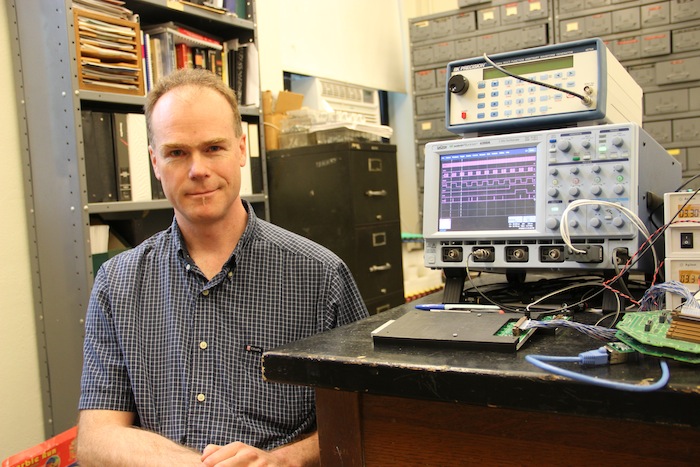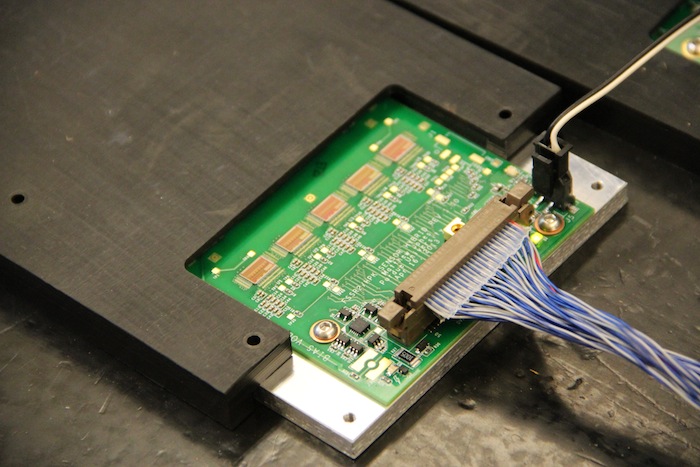Higgs boson: One year later
10-03-2013
Author(s):Tim Brouk
Before fireworks lit up the night sky, the world of science was the one making explosions on July 4, 2012.
It was official: The elusive Higgs boson had been discovered after a decade of experiments at the Fermi National Accelerator Laboratory provided only tantalizing suggestions of its existence, a year of running the Large Hadron Collider provided the definitive proof. Thousands of scientists had worked on the search for the particle named after Peter Higgs, a British theoretical physicist who 50 years ago proposed the existence of a yet undiscovered boson existed in order to give mass to elementary particles.
Matthew Jones, an associate professor in the Department of Physics, remembered the build-up to Higgs well. The first indications were revealed in October 2011 but thousands of tests were needed to make sure the new, previously theorized particle did indeed exist. Finally, as temperatures rose in Midwest America, the Higgs was released to much fanfare.
Higgs was the science story of 2012 but little has been mentioned of the new particle in 2013, at least in mainstream media. Jones said there is still a lot of work to be done with the Higgs in 2013 and beyond.
“My hope is it becomes part of standard knowledge, like atoms. Higgs is why we have mass,” said Jones, a member of the CMS experiment at CERN.
Question: What was it like around the Department of Physics during the Higgs discovery?
Answer: There were more requests than usual to talk to people about the Higgs and what its significance is. That was unusual. Usually the public is aware of particle physics as being a cool field: “They do something. I’m not quite sure what but they use big machines that cost a lot of money.” But I think everybody heard about the Higgs boson. … Everybody was aware and it certainly made its way into popular culture.
Q: Why did the public latch on to it so much?
A: I think it had good PR and it had good PR leading up to it. It had some bad PR but sometimes bad PR is good. I think there were a lot of catchy things with it that people could remember. It was called the God Particle, which is kind of unfortunate but it got people’s attention.
It was building up so much that if they didn’t find it, it would have been a big disaster. I think people were sensitized to it and when it was announced, people were primed for it.
There hadn’t been any really, really big discoveries for quite awhile. I think that was one thing the public can appreciate about particle physics: We discover new particles.
I gave a couple talks emphasizing the discovery of the Higgs as a little bit more than just adding another particle to the collection. It’s like the cornerstone or the underlying piece needed to make the entire theory work and explain why we have everything else. … Explaining the details of spontaneous symmetry breaking and quantum field theory is not something so easy to do in an hour or half hour. I’ve tried. … I think the existence of the Higgs is this fundamental confirmation that special relativity quantum mechanics is the right way to describe the universe and Higgs is the natural conclusion if you follow that chain of logic.
Q: What work has been done on the Higgs since the July 4, 2012, announcement?
A: The first thing has been including more data. We continue to run through the collected data and now we can look at production using different ways. Before, it was observed looking at two very high-energy photons. … Once you found the Higgs, the real question is: Is it the kind of Higgs you think it is? The mechanism proposed by Peter Higgs is really the simplest of many possible mechanisms. There are a lot of things you can test. You want to measure a lot of the properties of the Higgs.
There are a lot of things that we would like to study but even now we don’t have enough data to, really, even make measurements in some cases so we really have to set limits. We’d like to study things like the Higgs decaying to bottom quarks. We’d like to study the Higgs coupling to top quarks but these are challenging measurements. We need more data. One of the primary reasons for the next year and half that the LHC will be shut down is that they can upgrade it and fix it so that when it comes back it will be close to the full energy it was designed for. Right now is a good time to shut down. To make the next quantum leap forward, we are going to need significantly more data. Rather than let it trickle in, we’d rather it be a fire hose. … They’ll be able to have more intense beams with more collisions often. There will be more interesting collisions more often. The hope is to double the data set more quickly.
Q: What are you working on this summer and fall?
A: I’m working on two aspects: One is that I’m analyzing data from the LHC. … We’re trying to do precision studies with this data and that’s something that’s kind of a new thing because proton collisions can be compared to colliding garbage cans. They’re complex objects. You don’t completely know what the quarks inside of them are doing once they collide. … The other thing is preparing for when the LHC turns on again. One of the things Purdue has been involved in is developing sensors for detecting particles as they travel through the detector. These are very precise detectors that are placed very close to the collision point. … One of the things that’s needed for characterizing the sensors are testing results. You don’t just put them in the LHC and hope they work. They will be tested this fall at Fermilab. … I’ve been very involved lately in developing hardware for the testing facility in Fermilab. That requires building high speed electronics to read out sensors and process the data in real time.
A circuit board developed by Physics Prof. Matthew Jones that will go to a sensor that will be installed in the Large Hedron Collider at CERN.


